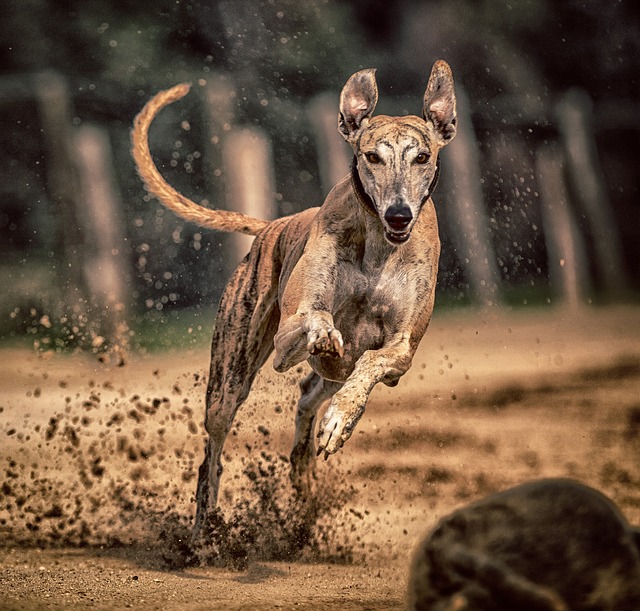


The Greyhound is a sleek and elegant breed known for its incredible speed and graceful appearance. They are primarily recognized as racing dogs, but they also make excellent companions due to their calm and friendly nature. Despite their athletic build and history as racing dogs, Greyhounds are surprisingly gentle and laid-back when at home, making them great pets for families and individuals alike.
Greyhounds are one of the oldest dog breeds, with a history that dates back over 4,000 years. They were originally bred in ancient Egypt and were highly prized by Pharaohs for their speed and hunting abilities. Greyhounds were used for coursing game like hares, deer, and other animals in open fields. Over the centuries, the breed spread to other parts of the world, and by the 19th century, Greyhounds became associated with racing, a sport in which they excel due to their speed and agility. Today, many Greyhounds are retired from racing and adopted as pets, where they thrive in homes that understand their unique needs.
The Greyhound is a medium to large-sized breed with a slim, athletic, and aerodynamic build designed for speed. They have long, muscular legs and a deep chest that allows them to take in large amounts of oxygen while running. Their short coat is smooth and can come in a wide variety of colors, including black, white, fawn, brindle, and more. Greyhounds have a narrow head, long neck, and large, almond-shaped eyes that give them an expressive, graceful look. They typically stand between 27 to 30 inches tall at the shoulder and weigh between 60 to 70 pounds. Their distinctive body structure allows them to reach speeds of up to 45 miles per hour in short bursts, making them the fastest dog breed.
Greyhounds are gentle, calm, and friendly dogs, often described as "couch potatoes" when they are not running. Despite their history as racing dogs, they are typically low-energy and enjoy lounging around the house. Greyhounds are known to be good-natured and can get along well with other dogs and pets, especially when introduced properly. They are not usually aggressive, but they do have a strong prey drive due to their history as hunting dogs. They are typically affectionate with their families and can be quite attached to their owners, seeking out attention and companionship. Though they are friendly, they can sometimes be reserved or aloof with strangers.
Despite their reputation as "couch potatoes," Greyhounds do require regular exercise to stay healthy. They enjoy short bursts of intense exercise, such as sprinting in a safe, enclosed area, but they are not as demanding as other active breeds. A few short walks each day, along with time to run in a securely fenced area, are typically enough to meet their needs. Greyhounds also enjoy a good romp in the yard or a visit to a dog park where they can safely interact with other dogs. After exercise, they are typically happy to relax and nap for the rest of the day. It’s important to note that Greyhounds should never be allowed off-leash in unsecure areas due to their strong prey drive.
Greyhounds are intelligent and generally eager to please, but they can also be independent-minded, which may make training a challenge at times. They respond best to positive reinforcement techniques, such as treats and praise. Due to their history as independent hunting dogs, they may not always be as responsive as some other breeds, but with patience and consistency, they can learn commands and proper behavior. Early socialization is crucial to ensure they are comfortable around other animals, people, and different environments. This breed is generally well-behaved but may require some time to adjust to life in a home, especially if they have transitioned from a racing career.
Greyhounds are generally a healthy breed, with an average lifespan of 10 to 14 years. However, like all breeds, they can be prone to certain health issues. Some common concerns include hip dysplasia, heart disease, and bloat (gastric torsion). Due to their thin coat and low body fat, they can be sensitive to extreme temperatures, so it’s important to keep them warm in cold weather and provide plenty of shade and water in hot weather. Greyhounds should have regular vet check-ups to monitor their health and ensure early detection of any potential issues. Their coat is low-maintenance, requiring only occasional brushing to remove loose hair. They also need routine dental care and nail trimming.
The average lifespan of a Greyhound is typically between 10 and 14 years. With proper care, including regular exercise, a balanced diet, and routine veterinary visits, they can live long, healthy lives. Many Greyhounds are retired from racing after a few years, and they often adapt well to pet life, living comfortably in homes with their new families.
© copyright Dog Compendium 2024 - 2025